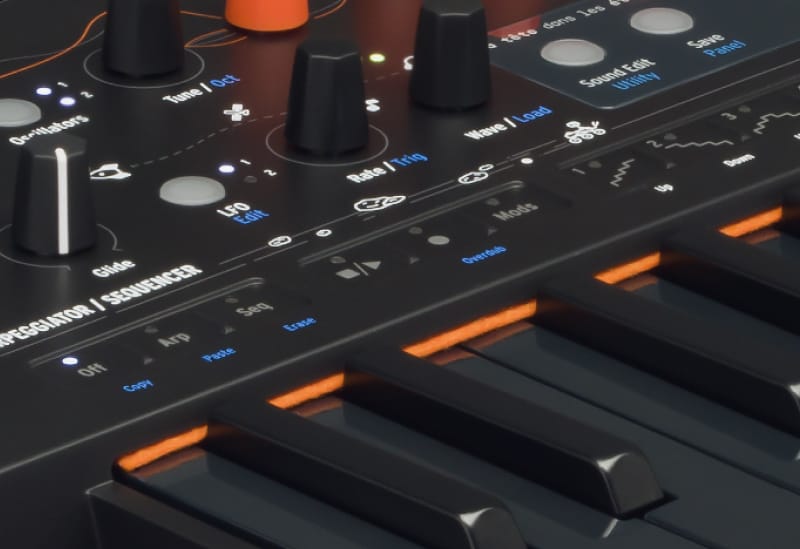Now updated to version 2.0 firmware and featuring a space-age lunar-inspired paint job, this limited edition model might be Arturia’s best Freak yet.

We’ve been fans of Arturia’s experimental Freak series since we reviewed the compact MicroFreak synth way back in 2019. The Freak series kicked off with one of the most interesting synths around, packed full of character and punching way above its weight in terms of value for money. When we reviewed the larger MiniFreak model last year, we were just as impressed by how it built on the original formula with true six-voice polyphony, dual sound engines and advanced effects. Just like the MicroFreak got a limited Stellar Edition release, so too the larger model gets it own Arturia MiniFreak Stellar Edition, featuring the same kind of space-inspired graphics on the panels and a cool all-black keyboard.
Crucially, the Stellar Edition also arrives with the latest version 2.0 firmware, which adds a bunch of new features compared to the original MiniFreak. That’s a huge part of the appeal of the MiniFreak Stellar – and we’ll get back to that shortly – but first let’s quickly recap what the MiniFreak is all about.

The MiniFreak is a six-voice hybrid synth, featuring a range of different digital oscillator engines which feed into six analogue filters and VCAs. Packaged into a larger keyboard format with a 37-note, velocity-sensitive, Slim keybed, the MiniFreak offers a different take on expression than the original MicroFreak, with conventional aftertouch as opposed to the touch-sensitive capacitive keybed of the Micro.
The MiniFreak has two simultaneous sound engines, each of which can draw on 23 oscillator modes. It’s billed as an experimental synth, but versatile might be a better term; you can explore a broad range of sounds from a lot of genres here. Just like the best analogue synths, the MiniFreak lends itself well to every kind of sound, equally adept at chunky baselines as it is silky modulated pads.

The sound and features of the Stellar Edition are essentially the same as the original MiniFreak, but a lot has changed since the MiniFreak was launched back in early 2023. Arturia’s commitment to upgrading their hardware speaks volumes here; the latest MiniFreak firmware is of course compatible with the older hardware and also provides the perfect opportunity to consider how much the MiniFreak has grown since the launch of that original model. The latest release is the 2.0 firmware (technically 2.0.0.1634 after a series of minor bug fixes, but we won’t get bogged down in that kind of granular detail). The big headline changes for the version 2.0 firmware are the introduction of a new wavetable oscillator engine, a new Super Unison mode for chorus-style supersaw effects, and advanced LFO options.

The wavetable engine is the most significant aspect of the 2.0 firmware update. One of the very appealing aspects of the MicroFreak and MiniFreak synth architecture is that installing new digital oscillators or engines can make quite substantial differences to the functionality of the synth, in a way which could never be achieved with analogue hardware. The wavetable mode is a nice, user-friendly example of wavetable synthesis, a digital approach made popular in the late 80s and early 90s thanks to synths like the Waldorf Microwave and Korg Wavestation. Wavetable synthesis operates using a bank (a ‘table’) of waveforms, usually closely related but subtly different, stepping through each one to generate different timbres. With the Wavetable engine loaded, the Wave control determines the position in the wavetable, the Timbre knob controls pulse width, and the Shape knob controls the low-pass/high-pass filter. A wide range of wavetables are included in the firmware update, bundled into the 64 new presets. In terms of expanding the MiniFreak’s sonic options, it’s hugely beneficial; wavetable synthesis is probably most closely associated with pads and modulated patches, but Wavetable works just as well for gritty techno bass or glitchy arpeggios.
The Super Unison mode and the new LFO/Shaper features are perhaps less dramatic improvement than the wavetable engine, but shouldn’t be dismissed. Super Unison effectively stacks detuned copies of the original signal on top of itself – up to six in total – to generate phasey, chorus-like effects. The level of detuning and filtering allows you to dial in more subtle tones or go to extremes and layer up thick patches of overlapping tones. The new Shaper mode rate, meanwhile, allows you to set whether a single step of the Shaper or the entire curve is controlled. Both changes add significant versatility to the MiniFreak’s already excellent range of sonic options.

Arturia as a brand are generally very good at supporting and developing hardware instruments after their initial release, particularly in the case of the Freak models. Bear in mind that the MicroFreak is now five years on from its original release, but also up to firmware version 5, effectively a far more versatile and powerful instrument than it was at the time of its release. It’s early days for the MiniFreak’s life cycle by comparison, but the Stellar Edition proves the point that these hybrid synths can evolve and develop over time. Thanks to the 2.0 firmware, the Stellar Edition is a remarkably versatile all-rounder, but of course the firmware also works with the original MiniFreak. The Stellar Edition offers the benefits of that striking murdered-out keyboard and space-age graphics, but whether you prefer this approach or the more conventional MiniFreak, both are superb instruments which surpass the power of that original MiniFreak release.
Greg Scarth
More info/buy